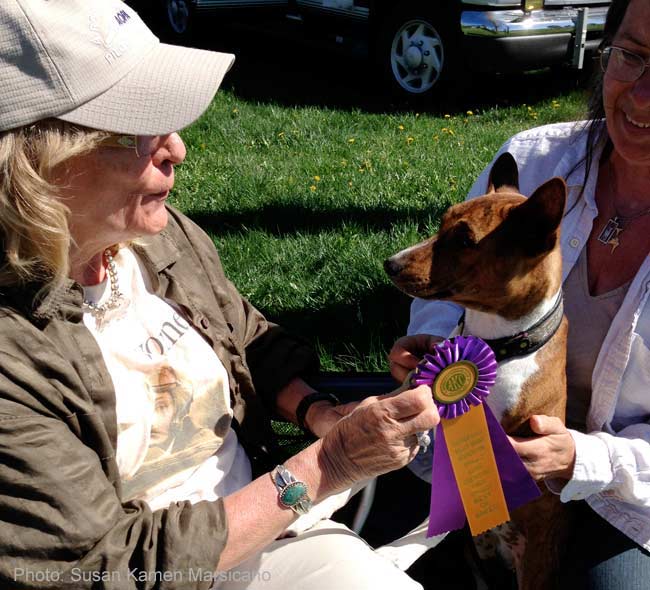The Basenji University
CLICK to return to College of Basenji Activities
203 Lure Coursing

Prepared by Susan Kamen Marsicano
What happens at a lure coursing trial?
Owners and Basenjis arrive at the trial in time for roll call. The host club members and judges are already working on and walking the course.

All breeds run the same distance on the day, a minimum of 600 yards. The very strong line is run through pulleys to make a continuous loop. The white lines in the diagram represent the legs of the course with the numbers giving the distance in each leg. The pulleys are shown by the red dots. The course starts at point "S" in the plan above and ends at point "F". The course pictured is a typical course, but they are never the same, and need to be tailored to the field being used.
The hounds are in pursuit of 3 plastic bags that are tied to the line.

The lure operator has to be able to see the entire course. The lure operator is shown here on an elevated platform. A good lure operator is essential to a good event. This person must understand how each breed runs to keep the lure running smoothly an appropriate distance in front of the pursuing hounds to keep their attention focused on it.

Each breed runs in DRAWS of up to 3. They wear racing jackets of yellow, pink or blue. The colors are also picked by draws. The judges only judge the colors.

The paddock master calls the hounds to the line. The hunstmaster asks the identity of the dogs in each color (just call names) and then reads the rules. Then he/she asks, "Handlers ready?" Then asks, "Judge ready? Lure operator ready?

Again, Handlers ready?" Then the huntmaster twirls his arm in the air. Huntmaster says Tally Ho! The hounds are released after the "T" in Tally Ho. The hounds run out of the slip leads, leaving them without collars. An early slip is a 1 to 5 point penalty.

And they are off.

Judges will have walked the course to know that is is safe. They position themselves where they are can see the entire course. There is a field clerk with the judge who adds up scores, checks addition, and brings the scores to the field secretary.

The Basenjis on the course.

The Basenjis coming into the Finish.

Handlers, waiting near the Finish, are told to "retrieve their hounds" by the huntmaster when he/she concludes that they course is over.
Each dog runs twice then the scores from the preliminary and final runs are combined to determine the placements in the stake. The first-place hounds in each stake of a breed are run off for best of breed. Sometimes the stake winners are from Open and Specials, sometimes also there is a Veteran Class winner.

Best in Field is made by running all the different breeds Best of Breeds together in draws of 3. So, you may have, for example, an Afghan Hound, a Whippet and a Basenji, for the 1st course, then a Ridgeback, a Saluki, and a Deerhound, for the second course. Above are two different typical mixes of breeds resulting from best in field draws. If there are ties, there are run-offs. Running your dog in the best in field competition is not mandatory.

The day ends with announcements of the winners, distribution of ribbons and sometimes trophies too. There is a great deal of cheering and good fellowship to end the day's event.
Return to "Some Answers to Your Questions"
Copyright the Basenji Club of America 2013 CLICK to return to College for Basenji Activities
Contact the Basenji University with comments, questions, updates and Workbooks at BasenjiU@basenji.org
.
We are indebted to the Basset Hound Club of America for the use of their Basset Hound University templates.